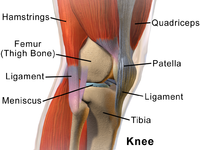
Photo from wikipedia
Abstract Anterior cruciate ligament and meniscal injuries are associated with secondary osteoarthrosis which may lead to functional impairment and economic burden. The prevalence of knee injury has not been studied… Click to show full abstract
Abstract Anterior cruciate ligament and meniscal injuries are associated with secondary osteoarthrosis which may lead to functional impairment and economic burden. The prevalence of knee injury has not been studied in depth. Our purpose was to report the prevalence of knee ligament and meniscal injuries and their associations with gender, body mass index (BMI), and height in young adults and to characterize individuals with meniscal injuries who gained full recovery. A cross‐sectional, population‐based study was conducted. Information on the disability codes of knee ligament and meniscal injury according to the Regulations of Medical Fitness Determination was retrieved from a medical database containing records of young prerecruits into mandatory service. Logistic regression assessed the association between genders, BMI, and body height to knee injuries. A total of 825,187 subjects were included. Prevalence of knee injuries was 0.35%. Males had 2.2‐fold more knee injuries than females. Increased BMI was associated with increased prevalence of knee injury in both genders, more significantly in females (overweight and obese females had an odds ratio of 1.406 and 1.519, respectively, to suffer from concomitant meniscal and ligamentous knee injury). Being underweight was associated with a lower prevalence of knee injury. An above normal BMI was more significantly associated with meniscal and/or ligament injuries that did not fully recover (females > males). Body height was associated with isolated meniscal injury in both genders. We found an association between BMI, body height, and knee injury in both males and females. Higher body height and higher BMI might be risk factors for knee injuries. Higher BMI was associated with greater probability of disability coding. Meniscal and ligament injuries are more common among males.
Journal Title: Journal of Knee Surgery
Year Published: 2017
Link to full text (if available)
Share on Social Media: Sign Up to like & get
recommendations!